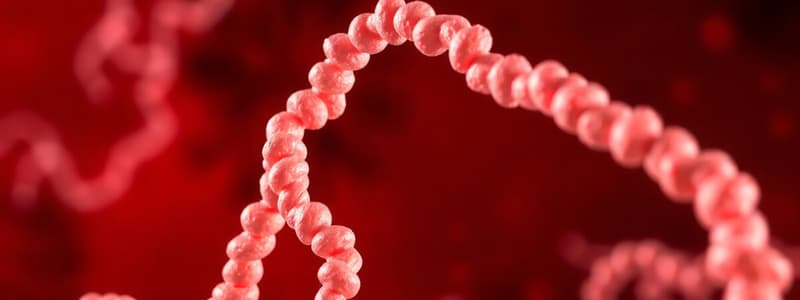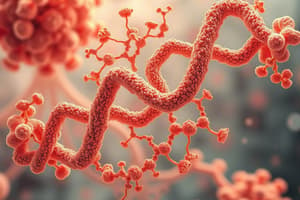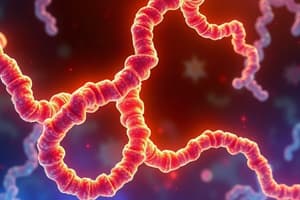Podcast
Questions and Answers
What is the predominant type of immunoglobulin found in mucosal areas and secretions?
What is the predominant type of immunoglobulin found in mucosal areas and secretions?
- IgA (correct)
- IgM
- IgE
- IgG
Which immunoglobulin is associated with allergic reactions and defense against parasites?
Which immunoglobulin is associated with allergic reactions and defense against parasites?
- IgE (correct)
- IgA
- IgD
- IgM
What is the earliest antibody synthesized by the fetus?
What is the earliest antibody synthesized by the fetus?
- IgD
- IgA
- IgE
- IgM (correct)
What function do Fc receptors on the surface of various cells serve?
What function do Fc receptors on the surface of various cells serve?
Which immunoglobulin exists in two forms, IgA1 and IgA2?
Which immunoglobulin exists in two forms, IgA1 and IgA2?
What are antibodies primarily classified by?
What are antibodies primarily classified by?
Which part of the antibody is responsible for binding to the antigen?
Which part of the antibody is responsible for binding to the antigen?
How are antibodies produced?
How are antibodies produced?
What do hypervariable regions in antibodies do?
What do hypervariable regions in antibodies do?
What is the role of the crystallizable fragment (Fc) of an antibody?
What is the role of the crystallizable fragment (Fc) of an antibody?
Which region of antibodies is responsible for providing flexibility to the antibody molecule?
Which region of antibodies is responsible for providing flexibility to the antibody molecule?
Which laboratory technique is used to separate proteins in serum for antibody detection?
Which laboratory technique is used to separate proteins in serum for antibody detection?
What type of immunoglobulin is predominantly responsible for the secondary immune response?
What type of immunoglobulin is predominantly responsible for the secondary immune response?
What percentage of plasma protein is comprised of antibodies?
What percentage of plasma protein is comprised of antibodies?
Which subclass of IgG is scheduled to have the shortest half-life?
Which subclass of IgG is scheduled to have the shortest half-life?
Which of the following chains is not a type of light chain found in antibodies?
Which of the following chains is not a type of light chain found in antibodies?
What are substances that trigger the production of antibodies called?
What are substances that trigger the production of antibodies called?
Which immunoglobulin has no subclasses?
Which immunoglobulin has no subclasses?
What is the primary function of membrane-bound antibodies?
What is the primary function of membrane-bound antibodies?
Which factor distinguishes the IgG subclasses from each other?
Which factor distinguishes the IgG subclasses from each other?
Which immunoglobulin is primarily found on the surface of B cells?
Which immunoglobulin is primarily found on the surface of B cells?
Flashcards
Antibodies
Antibodies
Glycoproteins produced by vertebrates in response to foreign structures called antigens. They specifically recognize and bind to these antigens.
Antigens
Antigens
Substances that trigger the production of antibodies and are recognized by them. They can be proteins, carbohydrates, or other molecules.
Serum Protein Electrophoresis (SPE)
Serum Protein Electrophoresis (SPE)
A laboratory technique that separates proteins in serum based on their size and charge. It helps diagnose various conditions by analyzing protein patterns.
Plasma Cells
Plasma Cells
Signup and view all the flashcards
Antibody Classes: IgG, IgM, IgA, IgD, and IgE
Antibody Classes: IgG, IgM, IgA, IgD, and IgE
Signup and view all the flashcards
Antibody Structure
Antibody Structure
Signup and view all the flashcards
Variable Region
Variable Region
Signup and view all the flashcards
Constant Region
Constant Region
Signup and view all the flashcards
IgM Antibody
IgM Antibody
Signup and view all the flashcards
IgG Antibody
IgG Antibody
Signup and view all the flashcards
IgA Antibody
IgA Antibody
Signup and view all the flashcards
IgE Antibody
IgE Antibody
Signup and view all the flashcards
IgD Antibody
IgD Antibody
Signup and view all the flashcards
Complementarity Determining Regions (CDRs)
Complementarity Determining Regions (CDRs)
Signup and view all the flashcards
Hinge Region
Hinge Region
Signup and view all the flashcards
Enzymatic Digestion of Antibodies
Enzymatic Digestion of Antibodies
Signup and view all the flashcards
Membrane-bound Antibodies
Membrane-bound Antibodies
Signup and view all the flashcards
Secreted Antibodies
Secreted Antibodies
Signup and view all the flashcards
Immunoglobulin G (IgG)
Immunoglobulin G (IgG)
Signup and view all the flashcards
Immunoglobulin M (IgM)
Immunoglobulin M (IgM)
Signup and view all the flashcards
IgG Subclasses
IgG Subclasses
Signup and view all the flashcards
Study Notes
Antibodies
- Antibodies are glycoproteins found in vertebrates.
- They are produced in response to foreign structures called antigens.
- Antigens are substances that trigger the production of antibodies and are recognized by them.
- Antibodies make up 20% of plasma proteins.
- They have diverse classes including IgG, IgM, IgA, IgD, and IgE.
Detection of Antibodies in Human Serum
- Serum Protein Electrophoresis (SPE) is used to separate serum proteins by size and charge.
- SPE helps diagnose various conditions by analyzing protein patterns.
- Antibodies are typically found in the gamma globulin fraction of serum.
Production of Antibody
- B cells differentiate into plasma cells after stimulation.
- Plasma cells secrete antibodies, which mediate humoral immunity.
- Antibodies are also known as immunoglobulins.
- They bind to antigens, a process which is followed by a chemical signal from helper T cells.
Antibody Structure
- Antibodies have a Y-shaped structure composed of four polypeptide chains.
- These include two heavy chains and two light chains.
- The chains are linked by disulfide bonds for stability.
- The tips of the Y are variable regions, binding to specific antigens.
- The constant region (stem of the Y) determines the antibody's class and role in the immune response.
- Antibodies have regions of extreme variability called hypervariable regions or CDRs which bind to antigens.
Fc and Fab Regions
- The antigen-binding fragment (Fab) of the antibody recognizes the antigens.
- The crystallizable fragment (Fc) interacts with other immune system components.
Antibody Binding Site
- The variable domains have three regions of extreme variability called hypervariable regions.
- These regions of variable domains bind to antigens, forming the antigen-binding site.
- Complementarity-determining regions (CDRs) are other names for these regions.
Variable Regions of Antibodies (CDRs)
- CDRs are located in light and heavy chains.
- They demonstrate high variability, specifically for antigen binding.
Binding of Antigen by Antibody
- CDRs bind to the antigen.
- The binding is due to the complementary structure between the antibody and antigen.
Flexibility of Antibody Molecules
- The hinge region gives antibodies flexibility, affecting how they bind antigens.
- Antibody flexibility in hinge region accommodates different antigen spacings.
Enzymatic Digestion of Antibodies
- Enzymes like papain and pepsin digest antibodies.
- Papain cleaves antibodies into two Fab fragments and one Fc fragment.
- Pepsin cleaves antibodies into one F(ab')2 fragment and various peptide fragments.
Membrane-bound and Secreted Antibodies
- Membrane-bound antibodies are essential for B cell activation upon specific antigen binding.
- This prompts B cell proliferation and differentiation.
Types of Heavy and Light Chains in Antibodies
- Heavy chains include gamma (γ), alpha (α), mu (µ), epsilon (ε), and delta (δ).
- Light chains are kappa (κ) and lambda (λ).
Classes and Subclasses of Immunoglobulins
- IgG, IgM, IgA, IgD, and IgE are immunoglobin classes.
- IgG has subclasses (IgG1, IgG2, IgG3, IgG4).
- IgA has subclasses (IgA1 and IgA2).
Immunoglobulin G (IgG)
- IgG is the most abundant antibody in serum, mostly produced during the secondary immune response.
- It provides long-term immunity and is the only antibody that can cross the placenta.
- Subclasses vary in their properties, including half-life, placental transfer, and complement fixation capabilities.
Immunoglobulin M (IgM)
- IgM is the first antibody secreted during an immune response.
- It's vital as a cell surface antibody.
- It has a pentameric structure and does not cross the placenta.
- Elevated IgM in newborns suggests intrauterine infection.
Immunoglobulin A (IgA)
- IgA is more abundant than other antibody classes, major antibody in secretions (saliva, tears, colostrum, breast milk).
- It provides mucosal immunity.
- IgA exists as a monomer and dimer. Secretory IgA is dimeric.
Immunoglobulin E (IgE)
- IgE levels in serum are low.
- IgE is involved in allergic reactions and defense against parasitic infections.
- IgE binds to mast cells and basophils, causing allergic reactions.
Immunoglobulin D (IgD)
- IgD is mainly used as a B cell receptor.
- It has a transmembrane region.
Functions of Antibodies
- Neutralization of toxins and viruses.
- Opsonization of microbes for easier phagocytosis.
- Antibody-dependent cellular cytotoxicity (ADCC).
- Complement activation to prevent microbial attachment to mucosal surfaces and initiate complement-dependent cytotoxicity (CDC).
Fc Receptors
- Fc receptors are proteins on various cells that recognize antibody Fc regions.
- Binding of antibodies to these receptors triggers various cellular functions.
Studying That Suits You
Use AI to generate personalized quizzes and flashcards to suit your learning preferences.




